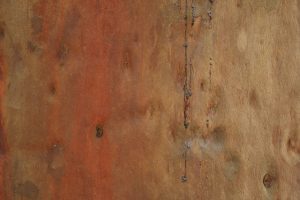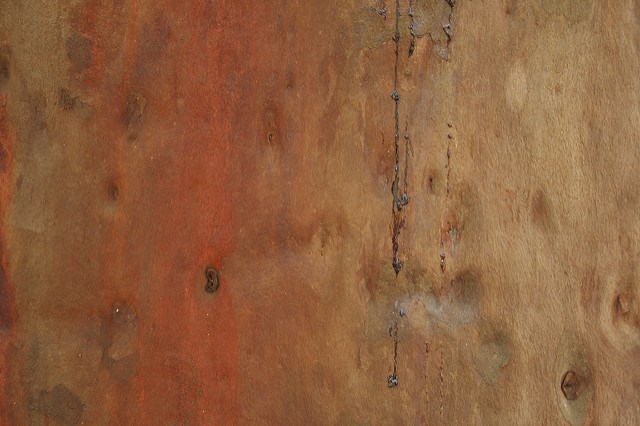Trees are a wonderful part of the world we live in, especially in the summertime, when their shade can help us withstand the summer heat. But those same trees can cause a mess for us when their sap gets onto everything from our car’s paint job, to the new deck we just installed.
Tree sap is, quite literally, the tree’s lifeblood, carrying nutrients from the roots up to the branches and leaves. But it doesn’t travel up veins and arteries, but rather in the soft layers of the inner bark. This means that it is susceptible to “bleeding” from the tree, especially if there is any damage to the tree’s bark.
When lumber is commercially harvested from trees, it is usually kiln dried (this isn’t usually done when someone uses their own sawmill). This is supposed to crystallize the sap, preventing it from leeching out of the wood. Even so, I’ve seen many a piece of lumber through the years, which still had sticky sap on it. I guess it just didn’t get hot enough in the kiln to crystallize the sap in those particular pieces of wood.
Whether it comes from a live tree or from lumber, the problem with tree sap is that it gets on things. If you’ve ever gotten it on your hands, you know that it can be hard to get off. Your hands might be sticky for days, until the last of the sap finally wears off.
Are there ways to get rid of thee sap? Fortunately, there are. In this article I’ll show you a couple of different ways of getting sap off of just about anything.
To start with, you need to determine what state the sap is in:
- Wet, sticky sap, perhaps with a dry skin
- Dry, hard sap
- Crystallized sap

Removing Sap From Wood
Dry hard sap and crystallized sap are the easiest to remove, assuming that it’s on a hard, smooth surface. The best is if you want to remove the sap from wood. In that case, all you need to do is use a sharp chisel. To do this, place the chisel on the surface, with the flat side against the surface. Then push on the end of the handle, popping the sap loose from the wood. You want to avoid hitting the back end of the handle, as this can cause the chisel to dig into the surface of the wood, marring it.
There may still be some residue left on the wood after this. It can be removed with acetone or lacquer thinner. If you are working on a new project and have fresh wood, you might want to sand it with 220 grit paper, after the wood dried, so as to smooth out the surface, equal with the area around it.
Of course, if you’re working on any new projects, you’ll want to remove the sap form the wood before painting it or staining it. These methods work just as well on fresh wood, as they do for wood projects that have been sitting in your yard for years.
Removing Fresh Sap
If you have fresh sap on wood, you can’t chip it off with a chisel. But there are still ways you can get it off. One is to warm the sap up with a heat gun, causing it to crystallize. To get it to do this, you have to get the sap to 140°F. That shouldn’t be hot enough to singe the wood, but you want to move the heat gun around on the surface you’re working on, so as to not create a hot spot and discolor the surface. Once the sap is crystallized, you can chip it off as mentioned above.
Fresh sap can also be removed by scraping off as much as possible with a putty knife and then using an oily soap, like Murphy’s Oil Soap to clean off the remains.
How to Remove Pine Sap from a Wood Deck
One common wood surface to end up with sap is on your home’s deck. That’s actually one of the easiest places to remove it. The sap you find on your deck probably won’t be thick, but rather show up as small, dirty spots. You can literally wash this off.
Once again, you want to use an oil soap, such as Murphy’s. Mop it onto the deck undiluted and allow it to soak in for 10 to 15 minutes. Once it is soaked in, scrub it with a stiff-bristle brush, soaked in water. Rinse the deck off with the hose, once you’ve scrubbed it thoroughly.
Removing Sap from Cars
Parking cars under trees can get sap on them as well; but we all like parking under a tree in hot weather, so that the sun doesn’t get our car so hot. Never fear, this can be removed as well. You can clean the sap off the paintjob on your car with rubbing alcohol, hand sanitizer (which contains alcohol), or acetone. For acetone, you can use oily nail polish remover, which contains acetone.
There is no problem using either the hand sanitizer or alcohol on your car’s paintjob. Alcohol won’t damage it. But you want to be careful using acetone on it. This is a strong solvent and it can damage the clearcoat on your car, if you use it too much. If it doesn’t come off quickly and easily, switch to something else.
Alcohol will remove wax from your car, but it will not hurt the paint job in any way. So you may need to wax your car again, after removing the sap.
Removing Sap from Clothing
Working under the trees, to get the sap off of other things, you might just end up with sap on your clothing. If this happens, it’s actually rather easy to get rid of it. First, put the affected articles of clothing in your freezer for about two hours to solidify the sap, being sure that the sap spots are not folded into the clothing. Then use a butter knife to pry the sap off of the clothing. With the bulk of it removed, you can wash your clothes like normal and they’ll come out perfect.
In the case of fabric upholstery for patio furniture, you might not be able to put the whole cushion in the freezer. Instead, use ice packs to freeze the sap, so that you can use this same procedure.




